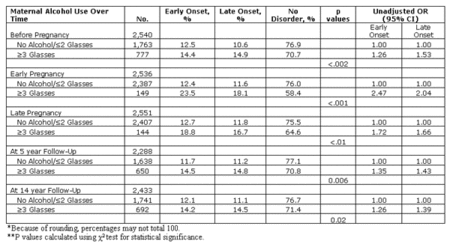Preliminary reports indicate that maternal drinking during mid pregnancy is (1) an independent contributor to the likelihood of alcohol consumption by age 14 and (2) significantly related to the development of alcohol disorders by age 21 (Baer, Barr et al. 1998; Baer, Sampson et al. 2003). This DRAM reviews a longitudinal investigation focusing on the associations between maternal drinking during early and late pregnancy and the development of alcohol disorders during early adulthood among offspring.
Alati, Al Mamun, Williams, O’Callaghan, Najman, and Bor (2006) interviewed 7,223 mothers who had their first antenatal visit at Mater Misericordiae Hospital in Brisbane, Australia between 1981 and 1984. Throughout the next 21 years, the researchers were able to complete five follow-up visits with 2,555 mother and child pairs (35.4%). At each interview, mothers recounted the quantity of alcohol they consumed during different stages of pregnancy as well as the amount they were consuming at the time of the interview.
Results indicated that 25% of offspring (n=640) met the DSM-IV criteria for a life-time diagnosis of alcohol disorders by age 21: 13% (n=333) reported the disorder before age 18 (early onset), and 12% (n=307) reported the disorder between ages 18 and 21 (late onset) (see Figure). Further analysis indicated that mothers who consumed more than two glasses of alcohol during early pregnancy, at an average of 18 weeks gestation, were 2.47 times more likely to have a child with an early onset alcohol disorder and 2.04 times more likely to have a child with a late onset alcohol disorder compared to mothers who drank two or fewer glasses of alcohol during pregnancy. Overall, the association between maternal drinking during early pregnancy and having a child with an alcohol disorder was stronger for early onset than for late onset.

Figure. Univariable associations between maternal alcohol use and onset of alcohol disorders at age 21 years (adapted from Alati et al., 2006). Click image to enlarge.
There were several limitations to this study. When researchers asked participants the quantity of alcohol they consumed, no specific measurement was stated as the standard volume of a single drink. The researchers assumed that the typical drink was 10 grams but participants could have used widely varying quantities. It is important to remember that only 35.4% of the initial cohort completed all five phases of the study, which increases the possibility that the final sample might not be representative of the total study population. Additionally, although the authors examined the effect of maternal alcohol and tobacco use during the follow-up period, there are many other unanalyzed risk and protective factors that could mediate the in utero exposure effect.
This study introduces the possibility that in utero alcohol exposure could be predictive of future alcohol disorders. However, many of the study features, including the lack of controls for additional influences, limits our ability to interpret these findings.
—Sara Kaplan
What do you think? Please use the comment link below to provide feedback on this article.
References
Alati, R., A. Al Mamun, et al. (2006). “In utero alcohol exposure and prediction of alcohol disorders in early adulthood ” Arch Gen Psychiatry 63: 1009-1016.
Baer, J. S., H. M. Barr, et al. (1998). “Prenatal alcohol exposure and family history of alcoholism in the etiology of adolescent alcohol problems.” Journal of Studies on Alcohol 59: 533-543.
Baer, J. S., P. D. Sampson, et al. (2003). “A 21-year longitudinal analysis of the effects of prenatal alcohol exposure on young adult drinking.” Archives of General Psychiatry 60: 377-385.




